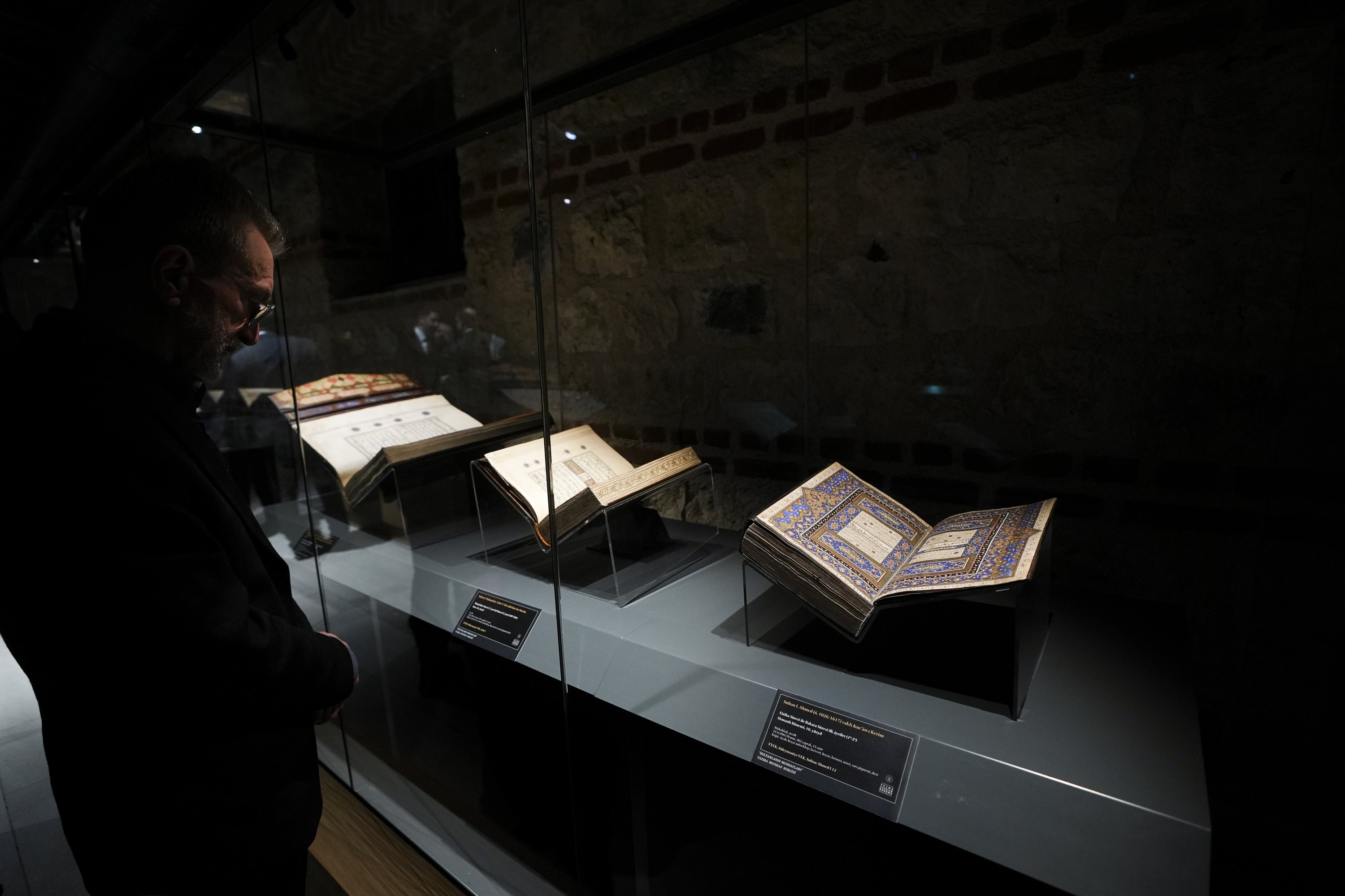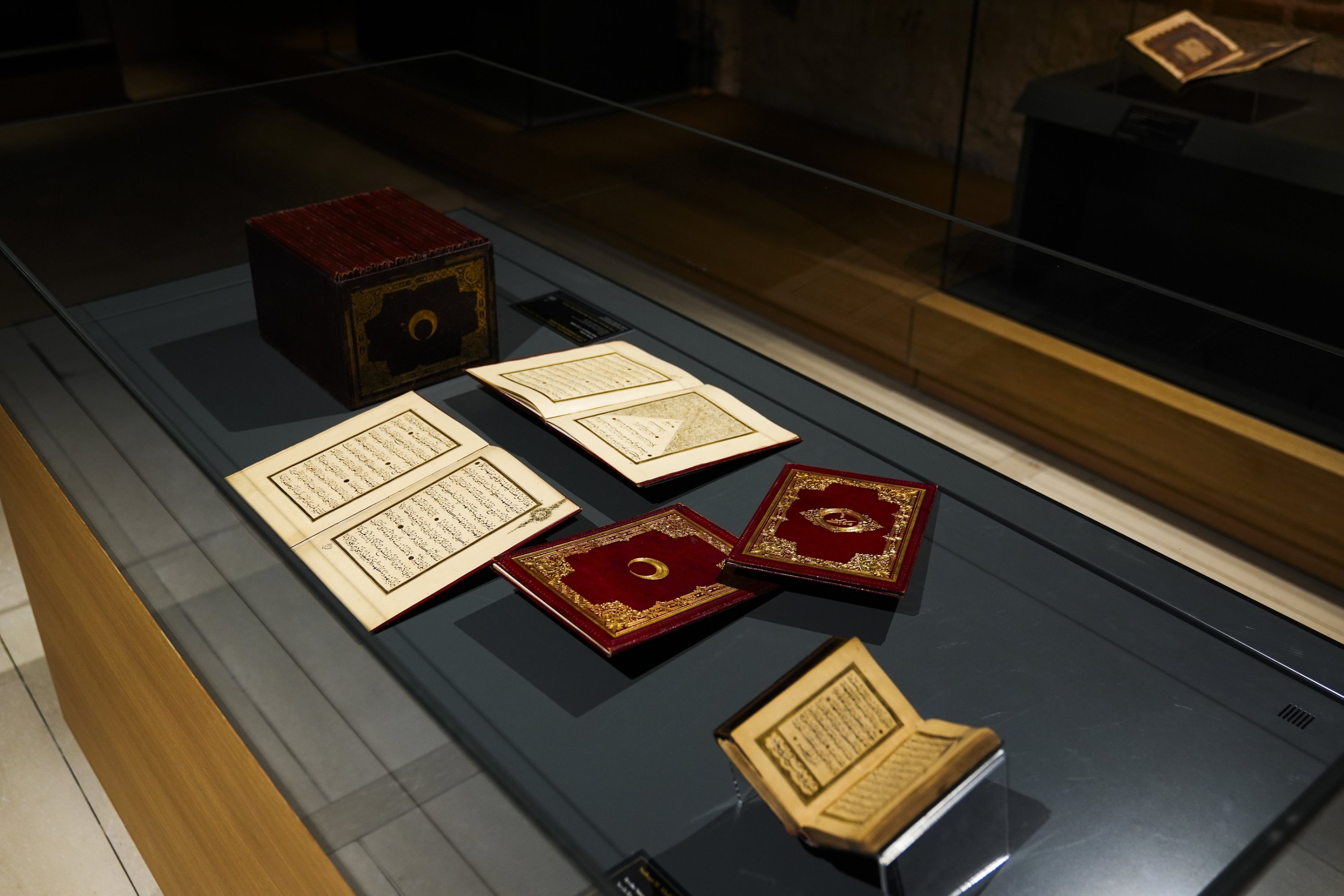© Turkuvaz Haberleşme ve Yayıncılık 2025
The "Mushafs of the Sultans" exhibition, showcasing Qurans from the collections of Ottoman sultans, spanning from Sultan Mehmed the Conqueror to Sultan Abdul Hamid II, was inaugurated at the Rami Library. Organized by the Turkish Manuscripts Institution (TYEKB), the opening began with a Quran recitation by professor Mehmet Emin Maşalı.
The event was attended by Culture and Tourism Minister Mehmet Nuri Ersoy along with TYEKB President Coşkun Yılmaz, Istanbul Provincial Director of Culture and Tourism Hüseyin Keskin, Turkish and Islamic Arts Museum Director Ekrem Aytar, Istanbul Foundation for Culture and Arts General Manager Görgün Taner, art historian professor Nazan Ölçer and calligraphers Mehmed Özçay, Hüseyin Kutlu, Fuat Başar and professor Hüsrev Subaşı, among many artists and art enthusiasts.
In his speech, Ersoy emphasized the Quran's role as a guiding light in life, stating: "It is the light and axis of our spiritual world. The profound respect and care our ancestors showed have made the divine revelation the subject of the most exquisite art applications in our culture and civilization. This exhibition allows us to witness the artistic and cultural richness of the Mushafs, showcasing the craftsmen's awe-inspiring patience, skill, meticulousness and sensitivity."

Ersoy highlighted that through their artistry, ancestors transformed Mushafs into special carriers of cultural heritage. He noted that many rulers and statesmen throughout history supported the continuation and development of practices requiring artistic and scholarly expertise, such as writing, decorating and binding Mushafs, by patronizing scholars and masters. Understanding the cultural value of mushafs endowed and gifted by sultans necessitates viewing them with this awareness and knowledge of these details.
The exhibition brings together a rare collection reflecting the works of great masters in calligraphy, the aesthetic understanding of their periods and examples reflecting the spiritual worlds of the sultans. Among the exhibited works are divine revelations penned by great calligraphers like Yaqut al-Musta'simi, Sheikh Hamdullah, Hafız Osman and Ahmed Karahisari, adorned by the most valuable illuminators of their eras and bound by master bookbinders, forming invaluable examples of our art history. Each is a stunning example of the refined tradition of these art forms, developed over centuries.
Ersoy pointed out that these Mushafs, under the patronage of sultans, especially in the Ottoman era, have been preserved and reached today thanks to a deep-rooted foundation tradition. He emphasized that the foundation approach is not just a gesture of aid, but a commitment to preserving, sustaining and advancing culture and civilization as a whole. The Mushafs in our exhibition are unique legacies left by the sultans who endowed them, an invaluable service of knowledge and culture they offered to their generations. Viewing the exhibition from this perspective reveals that it is not just an art event but an opportunity to connect with the greatness and richness of our culture and history through the elegance of art. Through such exhibitions, it is our duty to carry the past into the future, to remember the artistic spirit of our ancestors that has resisted centuries and become classic, and to recall the convergence of knowledge and wisdom with aesthetics through these rare works – a duty we are proud to fulfill.
Ersoy mentioned the launch of the "100+2 Periodic Museum Exhibitions Project" last week, with the first exhibition, "From Nature to Art: Wood," opened at the Ethnography Museum, showcasing the unparalleled level of Ottoman wood craftsmanship. He stated that these exhibitions, under various themes and contents, will continue in 44 cities until the end of the year, acknowledging the responsibility to pass on the thoughts, stances, perceptions and reflections of the past to future generations. Art will continue to be a means to fulfill this responsibility.

Highlighting the mission undertaken by the Turkish Manuscripts Institution, Ersoy announced that they have already published the Mushafs of Sheikh Hamdullah and Hasan Rıza, two of the greatest masters in the history of calligraphy and plan to publish the Quran of Şevki Efendi, another great Ottoman calligrapher, soon. This special Mushaf is being prepared for publication by one of the most important living masters of our calligraphy art, Mehmed Özçay, to whom Ersoy expressed gratitude for his contributions.
Ersoy also noted that efforts to establish a Mushafs Department within the TYEKB are ongoing. Additionally, by utilizing technological means optimally, they are both digitally preserving manuscript works and making them accessible to all interested parties. Through the Manuscripts Database, it is now possible to access the records and digital images of hundreds of thousands of works, with continuous improvements to achieve better outcomes.
Yılmaz pointed out that the institution is celebrating its 15th anniversary this year, stating that, as a historian, the history of manuscripts is considered in terms of before and after the Manuscripts Institution. He expressed gratitude to the president for the institution's establishment, which has, for the first time, demonstrated the will to gather our manuscript works under one roof. Yılmaz also mentioned that the institution is working on many important projects to be implemented in the near future.
Following the speeches, Ersoy was presented with a work of marbling art by Yılmaz.
The "Mushafs of the Sultans" exhibition, featuring a unique collection of Qurans compiled over approximately 11 centuries, from the Abbasids to the 19th-century Ottomans, will be open for viewing until the end of April at the Rami Library.
